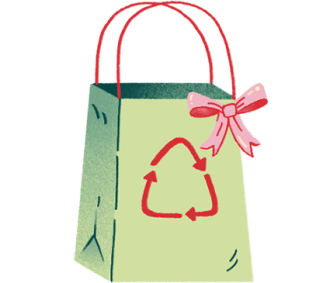The holiday season is once again upon us — a time of year that, no matter your religious affiliations, seems inextricably tied to buying. The materialistic ideology of the Western world demands that a jaw-dropping quantity of goods be manufactured, shipped, sold, and eventually thrown away all in the name of festive cheer. And even for many climate-concerned individuals, moving away from that mindset (as laughably basic as that sounds) has proven surprisingly difficult.
But what better moment to push that climate-friendly transition than, if you’ll forgive this cynical take, the most consumerist time of the year? If you’re thinking, After living through 2021? How do you expect me to incorporate climate change into my gift list? then I have good news. The decision isn’t all or nothing. You can take on any degree of change you want in your holiday prep — from choosing a greener form of wrapping paper to challenging the consumerist ideals at the heart of our economy.
Choose one:
What kind of climate-inspired gift-giving makeover do you want to pursue this year?

Sweat the small stuff
Small-scale changes to your personal habits often get scoffed at for missing the bigger picture, but the little decisions we make really can add up. The following tweaks allow you to keep the traditions you love while encouraging you to consider what needs to change on a larger scale.
Ready? Here we go.
How can I keep the environmental impact of my Christmukkah cards as low as possible?
Since you are rightly concerned about postal gas use, a second approach to waste reduction would be reducing the size of the card. Let’s say you usually send a folded card inside an envelope. Maybe it’s a ridiculously small change, but you could go with a folded card that is its own envelope. Print the greeting on one side, fold the card in half and address it on the back. Close it with a wafer seal. Right there you’ve cut your paper use in half and reduced a tiny amount of weight in your mailing. A postcard would be even lighter. I’m not sure whether that will significantly cut down on postal trips or gas use, but it’s worth a thought.
Now, consider the e-card: By keeping things online, you altogether eliminate the resources associated with manufacturing, printing, and shipping your holiday cards. Sure, there’s still the energy footprint of the servers that store and send your digital greeting, but that’s true of every email you send. Most of us don’t take this cost into consideration in our everyday messaging, so why fixate on it in the case of this particularly meaningful missive?
But let’s acknowledge that at this particular moment in history, there are few things people look forward to less than an additional email. Our inboxes are already bloated with 40 different kinds of spam and 50 different requests that we do something unpleasant, inconvenient, or both. In short, people rarely derive joy from email. There’s a good chance your e-card will get lost in the daily digital deluge, or simply glossed over when perused on a screen.
So ask yourself: What’s the ultimate goal behind the holiday card? I assume you want the recipient to know you’re thinking about them, and to maybe share something about your life with them. This is achieved — arguably in a more meaningful way — with a phone call. Even though the large-batch holiday card mail-out, digital or snail, allows for you to contact more people, the holiday phone call allows for you to really catch up with the people you love most. And isn’t that what will really warm hearts, no last-minute trip to the post office required?
— Eve Andrews, staff writer
Next question, please.
OK, that’s enough for me!Great work today! Come back whenever you want more advice!
What’s the most environmentally sustainable way to wrap a gift?
The evergreen answer here is: to not wrap it at all. I know, that’s not very fun or festive. If you’re doing a big family gift exchange at someone’s home, one option is to hide the gifts, challenging the recipients to go find theirs with clues. This maintains the element of surprise — and fun! — without the waste of wrapping paper. And if you’re mailing the gift, you could make the package itself into a sort of wrapping by decorating it with drawings or collage.
But if you’re committed to the wrapping practice — which is understandable — here’s Umbra’s advice from December 2020:
Keeping and reusing wrapping paper and ribbon and gift bags over and over again, for years and years, is an admirable option. Avoid metallic and glittery paper, because those contain plastic or aluminium that prevent them from being recycled with paper products and therefore go straight to the landfill. (And try to strip excess tape and sticky tags and whatnot from the paper before you recycle it, but a couple of stray pieces probably won’t hurt.) Fabric ribbon is preferable over the plastic curl-able kind, because you can more easily keep and reuse it. The more hardcore enviro-heads use brown kraft paper, which is eminently recyclable, compostable, and reusable, and you can draw stuff on it, stick some pine sprigs in the ribbon, go wild!
But the mantra of any environmentalist’s life should be to not lose sight of bigger, systemic problems, such as the large slice of emissions that come from transportation and manufacturing. If your family members are wrapping 100 Amazon Prime-shipped items in 20-year-old paper, for example, there’s a bit of cognitive dissonance there.
— Eve Andrews, staff writer
Next question, please.
OK, that’s enough for me!Great work today! Come back whenever you want more advice!
We always bake Christmas cookies to give away. How do we ensure they’re as environmentally friendly as possible?
Nothing heralds the winter holidays like the smell of baking cookies wafting from the kitchen, but even rugelach and peanut butter blossoms can carry some climate guilt in addition to the caloric kind. But plant-based chefs have perfected many creative ways to lower the environmental impact of your holiday treats! Here are some cookie ingredients to watch out for, and their easy Earth-friendlier replacements.

Butter. Emissions-wise, this delicious foundation of holiday cookies might as well be a lump of coal in your mixing bowl. Animal product ingredients are more carbon-intensive than plant-based ones. Butter is essentially just super-concentrated milk fat, which is produced by cows that burp a lot of methane and require a lot of land. As a result, butter’s per-pound emissions are higher than poultry and pork! But there’s an easy fix: Swap in a vegan butter or plant-based oil that’s solid at room temperature, like in these vegan shortbread cookies. While you’re at it, replace heavy cream with naturally high-fat coconut cream, and dunk your cookies in a plant-based milk!
Eggs. From pfeffernüsse to fudge, it can be hard to get through holiday baking without eggs. But like butter, eggs are more carbon-intensive than their plant-based alternatives. A substitute like aquafaba – the surprisingly useful liquid that drains off a can of chickpeas – both binds and adds moisture to cookies (and whips up into a snowy vegan meringue!). You can also use a quarter cup of applesauce in place of each egg.
Almonds. A word to the wise: Go easy on these standbys of confectionery fillings, which need oodles of freshwater, pesticides, and fertilizers to grow. In fact, if you really want to shrink your cookie footprint, skip tree nuts and opt instead for peanuts! Vegan peanut brittle, anyone?
Bonus: Use sustainably produced spices. Spices aren’t big carbon offenders, but they are seriously endangered by climate change. The vanilla in your sugar cookies and the cinnamon in snickerdoodles are picky about their growing conditions, and many of the places they are typically grown are being hit hard by rising temperatures, heavy rains, and typhoons. If you need to restock the spice drawer – and if your spices are more than a couple years old, you probably do, unfortunately – consider a retailer that supports climate-resilient growing practices and fair wages for farmers, like Diaspora and Co.
At the end of the day, most food-related climate woes are systemic issues that require policy solutions – like government support for low-resource agriculture and plant-based diets. But in the meantime, see how far a batch of sustainable treats at your next family gathering can go in spreading the climate-friendly cheer.
— Caroline Saunders, host of “The Sustainable Baker” podcast
OK, that’s enough for me!There’s no shame in a breather. See you soon!

Reduce shipping and packaging
So you’ve decided it’s time to start rethinking your buying behavior — congrats! These suggestions will bring your awareness to a particularly nefarious villain of the holiday season: waste. The most obvious culprit is all the packaging associated with gifts. There’s the explosion of plastic air cushions tucked into a box to protect your new phone, the many plastic sleeves ensconcing a single shirt, and the comically large cardboard boxes used to transport tiny little objects. You also have to wonder at all of the fuel that comes from shipping so many heavily padded and packed orders.
Where to begin? Well, follow me:
How much of a difference does it make if I, a procrastinator, use express shipping all my gifts instead of regular shipping?
I’ve got some bad news for all the last-minute gift-getters out there: Express shipping generates more emissions than almost any other shopping method, including both traditional delivery and in-person store shopping. The more you rely on next-day delivery, the more environmental costs you’re going to rack up.
The explanation for this is straightforward. Imagine a company that sells winter hats, and at any given time this company is receiving a steady flow of orders from customers in Chicago. If the company has five days to fulfill each order, it can bundle a bunch of different orders together and send them out to Chicago on a single truck. But if it has to fulfill every order by the following day, it’s going to send a truck out to Chicago every day even if it hasn’t received enough orders to fill it up. The extra dollars you pay for next-day delivery helps to compensate the company for the labor and fuel it uses on those extra runs, but it doesn’t accurately reflect how much fuel is wasted on inefficient routes and packing.

We don’t have enough data to quantify the total excess emissions from express delivery writ large, but we do know that the overall number of holiday package deliveries has more than doubled over the past decade. Given that many companies now offer one- and two-day shipping for no extra cost to compete with certain online retailer behemoths, it’s a safe bet that many of those trips were less efficient than they could have been.
The best approach for the average holiday shopper is to order items with plenty of lead time, select the slowest available delivery option, and bundle your items from the same retailer together as much as possible. And given the ongoing supply chain crisis, and the potential for longer delays, you’ll want to nail down that gift list even earlier than usual.
— Jake Bittle, freelance reporter
Next question, please.
OK, that’s enough for me!Great work today! Come back whenever you want more advice!
How much does “buy local” matter from a climate/environment perspective?
It’s not very satisfying, but the answer is: It depends. The environmental costs of gifts from clothing to pottery to greeting cards can vary a lot from company to company, and local outfits aren’t necessarily any more resource-conscious than their larger competitors. A small-time artisan or local business may use more sustainably produced supplies and pay its workers higher wages, but many megacorporations benefit from the massive scale of their operations, which may mean that they emit less carbon per item produced.
But Elizabeth DeSombre, a professor of environmental science at Wellesley College who has studied how consumers make decisions about the environment, says the issues at stake in the choice of small local store versus big multinational corporation aren’t about climate change so much as community integrity. When it comes to carbon emissions, our individual consumer choices don’t matter as much as the laws and regulations that govern the structure of the supply chain. But a purchase from an independent local business sustains “the character of the places we live and the people in our communities,” she says. “That’s much more important than any climate or environmental effect those purchases are likely to make.”
Essentially, DeSombre advises: “When faced with a reasonable set of choices, we should pick options that pollute less, and create less waste, and support the values and the communities that are important to us.”
If you’re thinking about doing all your shopping locally as opposed to ordering online, you could reconsider doing it in a car. The fuel required for driving a combustion-engine vehicle around town to a dozen different stores means that from an emissions perspective, you’re better off just ordering all the items online (but refer back to the question above for the best ways to do that!). The optimal way to shop is to go by public transportation, bicycle, or simply walk.
— Jake Bittle, freelance reporter
Next question, please.
OK, that’s enough for me!Great work today! Come back whenever you want more advice!
With all the supply chain interruption this year, are returns more likely to go to waste? How often do returned items get thrown out in a regular year?
Even before the pandemic and the supply-chain disruptions that came with it, delivery returns were inefficient and wasteful. Getting an unwanted order back to its manufacturer entails a journey through the shadowy world of “reverse logistics,” a slower and less efficient network that ships items from post offices to sorting facilities and back to manufacturers. And returns are basically a built-in feature of e-commerce, where you have no access to a dressing room: Even before the online shopping explosion of the pandemic, researchers estimated that Americans returned more than 1.5 billion items each year, and that number has likely only increased since then.
The vast majority of these returned items will not be marketed and sold again, and that’s for a few different reasons. For one thing, it may not be safe or sanitary to sell the item back to someone else, as is the case for many beauty products. But in many other cases, it’s just too expensive. The combined costs of delivering an item back to a sorting facility, paying someone to check that it’s in good condition, repackaging it, and inserting it back into the forward delivery supply chain can easily exceed the profits a manufacturer might make from selling the item again. For many manufacturers, it’s cheaper just to check that the return is legit, issue a refund, and dump the returned item at a landfill.
It’s hard to say how the pandemic supply chain crisis will affect the fate of these returned items, but the outlook isn’t promising. The cost of shipping is higher now than ever before, and delivery backlogs will make it harder for manufacturers to turn around and resell returned items in an efficient and timely manner — after all, they’re having a hard enough time getting orders out to buyers the first time around.
You, as that buyer, can avoid trashed returns by regifting, donating, or repurposing unwanted items, but real change on the issue may have to come from the top down. In 2020, the French government passed a first-of-its-kind law that prohibits businesses from destroying or discarding unsold goods. Even items like cosmetics and hygiene products must now be reused or recycled — part of what the law calls a transition from a “linear economy” to a “circular economy.”
— Jake Bittle, freelance reporter
OK, that’s enough for me!Don’t worry — it’s about the journey, not the destination.

Minimize your impact!
You knew we were gonna end up here: Everything you buy — yes, everything — has some sort of environmental impact. You may not quite be ready to eschew the holiday gift-buying urge altogether, and that’s OK! But let’s talk about what is in your power, as a buyer of things, to minimize that impact.
Ready for things to get complicated? Read on!
When a company tells me that I can offset whatever I buy, is there any way to know whether that offset is legit? Should I pay attention at all?
There’s a long answer and a short answer. The short: Ignore it. It might be a good thing, or it could be a waste of money, and it’s almost impossible to know which unless you devote your life to monastic study of the subject.
Perhaps the easiest way to understand offsets is to look at it from the perspective of the business itself. Let’s say you are a truly well-meaning entrepreneur who has built up a business making gorgeous electric bikes. You’ve spent thousands of hours researching every little thing to make your business environmentally sustainable: green energy, minimal waste, low-impact manufacturing. But to fully eliminate your carbon emissions, you’d need to knock down your factory and build a greener one from scratch. Suffice it to say, that’s not a cheap business solution!
That’s when your chief sustainability officer suggests you buy offsets from a company buying up acres of the Amazon rainforest, ostensibly to protect it from land-grabbers. For a fraction of what you would have spent on the new factory, you could keep an area the size of Yosemite National Park from going up in flames and releasing an order of magnitude more carbon than you will ever generate with your company. So you end up going the offsets route.
But a few months later, you get a call from a journalist asking where exactly your “Yosemite in the jungle” is. Uh-oh: Turns out, it’s part of a portfolio of projects scattered over a region. There’s no clear paper trail showing exactly which lands you saved — if any. The journalist points out that forests in the area went up in flames after a recent lightning storm, along with the carbon you were paying to sequester. Not only that, the forest that’s left was already protected by local Indigenous tribes who never saw a dime of your money. So how much effect did your purchase really have? It’s impossible to pin down.
It’s clear that some offset money really does make changes on the ground — and these kinds of “high-quality” offsets are really expensive. There’s plenty of debate about how much money it takes to pay for the damage of emitting a ton of carbon: Maybe $100, maybe $300 if you include the loss of life, or less than $6 according to former President Donald Trump’s Administration. The fact that the majority of carbon offsets sell for less than $5 a ton suggests that most aren’t actually changing anything on the ground.
And this is all assuming that everyone involved is honestly trying to do the right thing. What happens when a business decides to act deceptively on purpose? As journalists at Grist, we’ve found offsets truly difficult to decipher, even after devoting months to investigations. It’s simply unrealistic to ask regular people to do the same every time they buy something.
— Nathanael Johnson, senior staff writer
Next question, please.
OK, that’s enough for me!Great work today! Come back whenever you want more advice!
How do I identify which companies have truly sustainably made products, and which ones are simply greenwashing?
I applaud your noble intentions, but I have some disappointing news. It’s still early days for sustainability in the wide world of manufacturing. While there are companies truly trying to clean up their supply chains, it’s going to require a new regime of transparency, new technologies, and new policies to get to a place where I can confidently tell you that one purchase might be less of a burden on our air, water, or climate than another.
That’s not to say every single sustainability claim that brands make today is meaningless, but they do tend to be oversimplified. That’s understandable, because the life of a product before it goes to market is incredibly complex. How can you address where your product stands among all the many impacts of mining, agriculture, manufacturing, and shipping, in one label or pithy claim? Advertising a product as “sustainable” because the factory uses water-saving processes or renewable energy could easily belie other unsavory attributes like toxic chemicals, pesticide-laden farms, or abusive labor practices. This is what experts call the “sin of hidden trade-offs,” or using a very narrow set of metrics to define “green.”
Even those narrow claims are rarely as good as they seem. Take this popular one: clothes made from recycled plastic bottles. Maxine Bedat, founder of the New Standard Institute, a nonprofit working for a cleaner, more transparent fashion industry, says the data on recycled polyester shows it has minimal greenhouse gas emission benefits as compared to virgin polyester. Sometimes companies claim they are keeping plastic bottles out of landfills, but Bedat said that’s not really true, because usually they are competing with bottling companies with their own sustainability goals for that material. Once you turn a bunch of bottles into a T-shirt, you can’t then turn it into something else.
It might be helpful to look at which companies have set “science-based targets,” or targets aligned with the Paris Agreement, for their greenhouse gas emissions. To Bedat, this is one of the more meaningful certifications because it requires companies to set emission reduction goals for every aspect of their business, including materials sourcing and transportation. That being said, this standard is more of an aspiration than a legally binding commitment. Alternatively, rather than getting overwhelmed by greenwashing, you might turn your frustration into action by asking companies directly for the information you want.
In this world of dubious claims, is it better to err on the side of buying the “green” product over the conventional one? That’s up to you. But better than that is buying a gift that you know will be used. If you buy the most sustainably produced item but it sits untouched for years before going in the trash, what have you really accomplished?
— Emily Pontecorvo, reporter
Next question, please.
OK, that’s enough for me!Great work today! Come back whenever you want more advice!
What are the characteristics of a gift with high reusable potential?
The first and more important characteristic of a gift that will have a long, useful life is that it’s something that the recipient will actually, well, use. All the resources and energy that go into manufacturing an infinitely durable object will have been wasted if the object never fulfills its intended purpose. Is your coworker actually going to take that monogrammed, insulated travel mug to their local coffee shop every day, or will it sit forsaken in their kitchen cabinet while they continue to buy their daily latte in a disposable cup?
Giving gifts that will actually be used requires that the giver know a fair amount about the recipient’s lifestyle, habits, and preferences. Depending on the culture of your family and community, there might be a taboo against asking people what kinds of gifts they want and need — but taboos and norms are exactly what have to change to shift culture in any direction. Every relationship is different, but I think it’s better to risk a little awkwardness in order to give someone something they’ll use and like than to risk wasting time, stress, money, and all sorts of environmental impacts on an unwanted present.
Beyond accurately matching your gift to the recipient’s needs, look for brands with strong warranty policies. What does that look like? Sock brand Darn Tough, for example, offers a lifetime warranty for all its socks, meaning that it will replace any pair that you wear a hole in. But do not mistake a generous return policy for a good warranty policy — unfortunately, merchandise that’s ordered online and then returned often gets discarded rather than resold.
In the world of electronics, look for brands with liberal repair policies — meaning that they make instructions, tools, and parts available if you want to repair your device or take it to an independent fixer. There’s a website called iFixit that collects detailed instructions for repairing all manner of devices (and other consumer goods) and rates smartphones, tablets, and laptops by how easy they are to repair. It’s a good idea to check out the site’s rating or repair instructions for the specific make and model you’re looking at to see how easy it’ll be to fix before you buy it.
If all else fails — if you’re buying a present for someone you know almost nothing about, or if the generous-warranty or easy-to-repair version of the product you’re looking for is out of your price range — remember that not all environmentally friendly gifts have to be reusable or long-lasting! If you’re looking to give something fun or something that you’re not sure the recipient will like, consider the secondhand market — more on that in the next level.
— L.V. Anderson, news editor
OK, that’s enough for me!We’re in it for the long haul, baby. Take a break!

Give more thoughtfully!
So you’ve spent some time grappling with the many murky questions of how to have the most climate-compatible holidays. That means you’ve probably realized that true transformation comes with some hard truths, the most salient being: We need to shift our cultural expectations. After all, it’s unlikely many people will adopt that behavior if they feel like they have to argue and fight against social norms. And that means attacking that holiday season third rail: uncomfortable conversations.
So, here are some ideas to change hearts and minds.
What’s the best way to make a thrifted or reused gift seem special?
Here are three reasons a secondhand gift is inherently more special than a new one, and none of them have a thing to do with its environmental footprint:
- You tend to be much more intentional with thrifted and secondhand presents because you have to hunt for them. That story behind your selection can also be a kind of gift you share with the recipient.
- A lot of what you find secondhand is a lot more one-of-a-kind than anything you can buy with two-day shipping off Amazon Prime.
- Many classic holiday gifts, such as books, art, clothing, jewelry, furniture, and cookware, are just as abundantly available secondhand as new. And especially in the latter categories, a lot of what you can find used is higher quality and arguably more interesting than what you’d buy straight from the factory today.
The idea of “used” being synonymous with “cheap” or “trashy” is pretty outdated in 2021 — you can find just as many, if not more, upscale purveyors of vintage goods today than bargain-bin charity shops. That said, any seasoned thrifter will tell you that there are better and worse secondhand stores, and you can’t always tell them apart by whether they’re high-end or low. (Even the bad ones sometimes have treasures!)
If you’ve got time and a high tolerance for quirkiness, embrace the joys of your local antique malls, used bookstores, flea markets, vintage fairs, and auction houses. But to be efficient, you should always go in with something of a rough game plan: your sister has been dying for eccentric cookie cutters, your boyfriend would love a taxidermied possum, etc.
And if you’re hesitant to venture outside and rummage around (and there’s certainly a climate argument to be made for not driving around to every antique mall in the tri-state area, as we discussed earlier) the internet is full of options. Find and follow local vintage sellers on Instagram or other social media platforms. You can get lost in the pages of the Etsy vintage market for days, where you have the added benefit of being able to search explicitly for what you want. For even more upscale options, there is no shortage of high-end consignment clothing and jewelry to be found online from companies like The RealReal. The site Live Auctioneers aggregates thousands of online auctions, which can traffic in a lot of very expensive art, but they also have a lot to offer at reasonable price points.
Just remember: How much you spend is not an accurate metric of how special the gift is!
— Eve Andrews, staff writer
Next question, please.
OK, that’s enough for me!Great work today! Come back whenever you want more advice!
How do I tell my family members that I want to give (and receive!) fewer presents this year?
Getting that message across often needs to be a gradual process, especially if bountiful heaps of gifts have long been part of your holiday tradition. If you want to avoid meltdowns and confrontations, you need to work by shifting expectations incrementally. Let’s explore a few potential frameworks for getting that conversation started.
For the children: Ask your kids to try to make a list of all the holiday presents they received last year, and then think about which ones they genuinely use or cherish a year later. Ask them to consider: What’s happened to all the other ones? How would their lives be much different if they had only received the gifts they still love and none of the others? What was it about those really loved gifts that make them special? Hopefully you reach a consensus and can edit down their wish lists accordingly.

For the teenagers: Adolescence is a ripe time to plant the idea that fewer possessions equal greater independence, but you don’t want to come off like you’re lecturing or dictating. So present this as a choice: Would you rather have the same amount of presents as usual, or would you want to receive fewer presents and one or two fewer weekly obligations (chores, lessons, etc.)? Never underestimate the appeal of getting more free time to spend however you like.
For the adults who want to buy you (and your family) things:
The goal here is not to dwell on your newfound (or long-standing, as the case may be) environmental virtues, since that kind of holier-than-thou sense of superiority will probably end up alienating your loved ones. Simply tell them: I love you, I love your generosity, but I simply cannot make a place for any more stuff in my home. The Konmari movement is hardly niche at this point, so this shouldn’t be controversial. If they ask if there’s one thing you really need or desire, tell them! Asking for what you want and will love and actually use — especially when prompted — should hardly be taboo.
But one reason that people give gifts is that that’s how they express love, and you don’t want to somehow communicate to them that you’re rejecting that. To prevent that, I suggest ramping up other forms of closeness in addition to your less-is-more gifts conversation: If you live far away, schedule more regular catch-up phone calls or to plan a trip to see each other; if you’re local, have more frequent get-togethers.
— Eve Andrews, staff writer
Next question, please.
OK, that’s enough for me!Great work today! Come back whenever you want more advice!
How do I move our holiday traditions away from exchanging things and toward something more meaningful?
Well well well! It seems that you are ready to take the consumerism out of Christmas. Follow me.
You did it, Tiny Tim! Reevaluating what we want and what brings us joy in our lives — even when it comes to something as small as Christmas cookies — is really important work. It’s the foundation of how we get around to preserving the planet. Well done!
Feel like you missed something?
Start over from the beginning here.
This article is part of the Ask Umbra 2021 Holiday Makeover.







